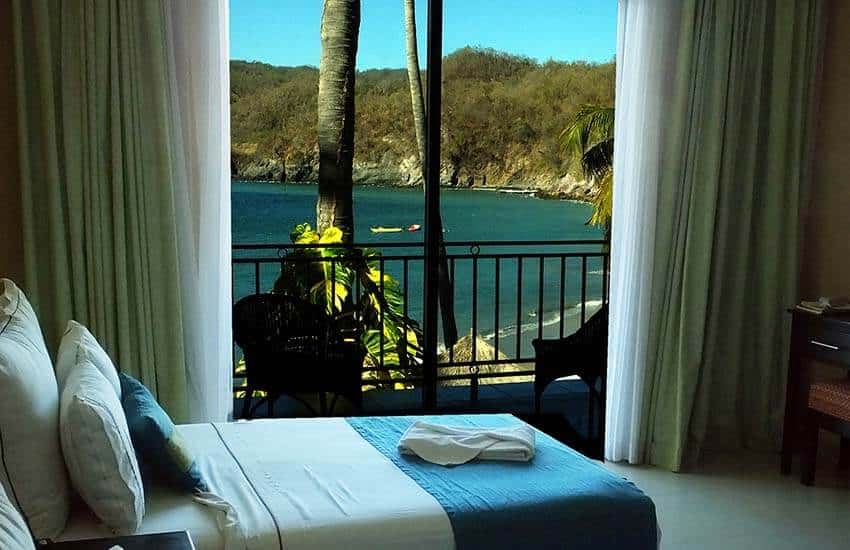While browsing the net for a nice beach we hadn’t been to before, we came upon a picture of Gran Bahía de Cuastecomates, located six kilometers northwest of Barra de Navidad, Jalisco, on the Pacific Coast.
True to its name, this is a “big bay,” but sheltered and with calm waters, a perfect place for old-timers and toddlers to enjoy the sea without fear of being smacked by a wave and turned upside down — in other words, a place where no surfer would ever choose to go.
So, not being surfers, my wife and I booked a room at the grandiose-sounding Hotel Quinta Gran Bahía de Cuastecomates, which turned out to be grandiose-looking as well, with some 75 rooms, each featuring a balcony facing the ocean and the beautiful bay.
As this hotel includes all meals as well as alcoholic drinks in its overall price, we stuffed ourselves upon arrival and afterward felt obliged to burn off the added kilos by walking “100 paces after eating,” advice given by none other than Mohammed the Prophet, according to my wife, Susy Pint, who ought to know, as she is author of the book Una Mexicana en Arabia (A Mexican Woman in Arabia).
The “prophet’s paces” took us to a street entering the pueblito of Cuastecomates.

What a strange street it was, impeccably paved without a single bache (pothole) and so wide that there were walking lanes on both sides of the street, separated from the driving area by evenly spaced iron stanchions.
Beneath our feet was a multi-grooved yellow strip stretching off into the distance, obviously designed to guide the blind. It was the safest, most intelligently designed street we’d ever seen, and we rubbed our eyes in astonishment.
“Have we been transported to Sweden or Germany?” we asked.
Even the sign showing the name of the street had an international flair. It was written in Spanish, English and Braille!
Well, we followed the yellow strip to a perpendicular street, just as beautifully designed, above which we found a banner informing us that Cuastecomates is a pueblo incluyente, which meant nothing whatsoever to us.
Soon we found a shopkeeper who explained that incluyente means “inclusive,” in other words, “including everything a handicapped or old person might need.”

It seemed that we had stumbled into Mexico’s first town and beach for the handicapped and aged on the Pacific Coast, the pet project of Lorena Jassibe, wife of former Jalisco governor Aristóteles Sandoval, who inaugurated the place in May 2016. The town has two hotels, each of which has a percentage of rooms adapted for clients with disabilities.
“They located the project here because our bay is so well-protected,” the shopkeeper told us, suggesting that we go see the amphibious wheelchairs there that allow the disadvantaged to roll along wooden walkways right into the warm seawater, where they can have fun along with everyone else.
We did just that and found that these specialized, cleverly designed vehicles can be rented for a token fee of 25 pesos per day.
As to our hotel, I should remark that it has four stars probably due to the great view guests get from their rooms. We found the place clean, the staff very friendly and helpful but the food remarkably bland and uninspiring.
There is also a noise problem on Friday and Saturday nights, when loud music is played from 8 p.m. to midnight. An easy solution is to ask, upon arrival, for a room far away from the music.
This hotel, however, does have three attractions you don’t want to miss: three playful raccoons that visit the outdoor dining area every evening after 7 p.m. with the intention of stealing as much leftover food as possible from the plates of guests.

Something else unusual for you to see on the grounds of the Quinta Gran Bahía is the great number of cuastecomate (Mexican calabash) trees, for which the bay is named. These trees produce a smooth, round, very hard, light-green fruit about the size of a grapefruit. It grows directly on its trunk, sometimes popping up in the most unexpected places.
These fruits are said to have numerous medicinal properties. A cough medicine, for example, is made by cutting off the top of the dried fruit and pouring alcohol into it. Because the dry seeds of the cuastecomate have quite a nice taste — some say it reminds them of licorice — this “cough medicine” is quite popular among people who don’t have a cold at all.
Finally, I should mention that the Gran Bahía de Cuastecomates has a certain fame for beautiful sunsets, so I had my tripod ready for action the two nights that we stayed in the area — and I found the rumors to be true.
The first evening’s sunset was very nice, but the following night’s was simply spectacular, the best I have ever experienced on any beach anywhere.
What to do at Cuastecomates beside swimming and sunset-gazing? Well, nine kilometers northwest of this beach — a 23-minute drive away — you’ll find one of the best places in Mexico for seeing crocodiles in an estuary.
Cocodrilario Ejido la Manzanilla is the biggest croc sanctuary in the country and features a 650-meter-long boardwalk that allows you to experience the flora and fauna of a mangrove forest without having to get into a boat.

This beach, identified as Cuastecomates Playa Incluyente in Google Maps, is a four-hour drive from Guadalajara whether you take the narrow, twisting road to Barra de Navidad or the toll road via Colima and Manzanillo. It’s paved road all the way.
To reach the crocodile sanctuary, ask Google Maps to take you to Cocodrilario La Manzanilla.
The writer has lived near Guadalajara, Jalisco, since 1985. His most recent book is Outdoors in Western Mexico, Volume Three. More of his writing can be found on his blog.








